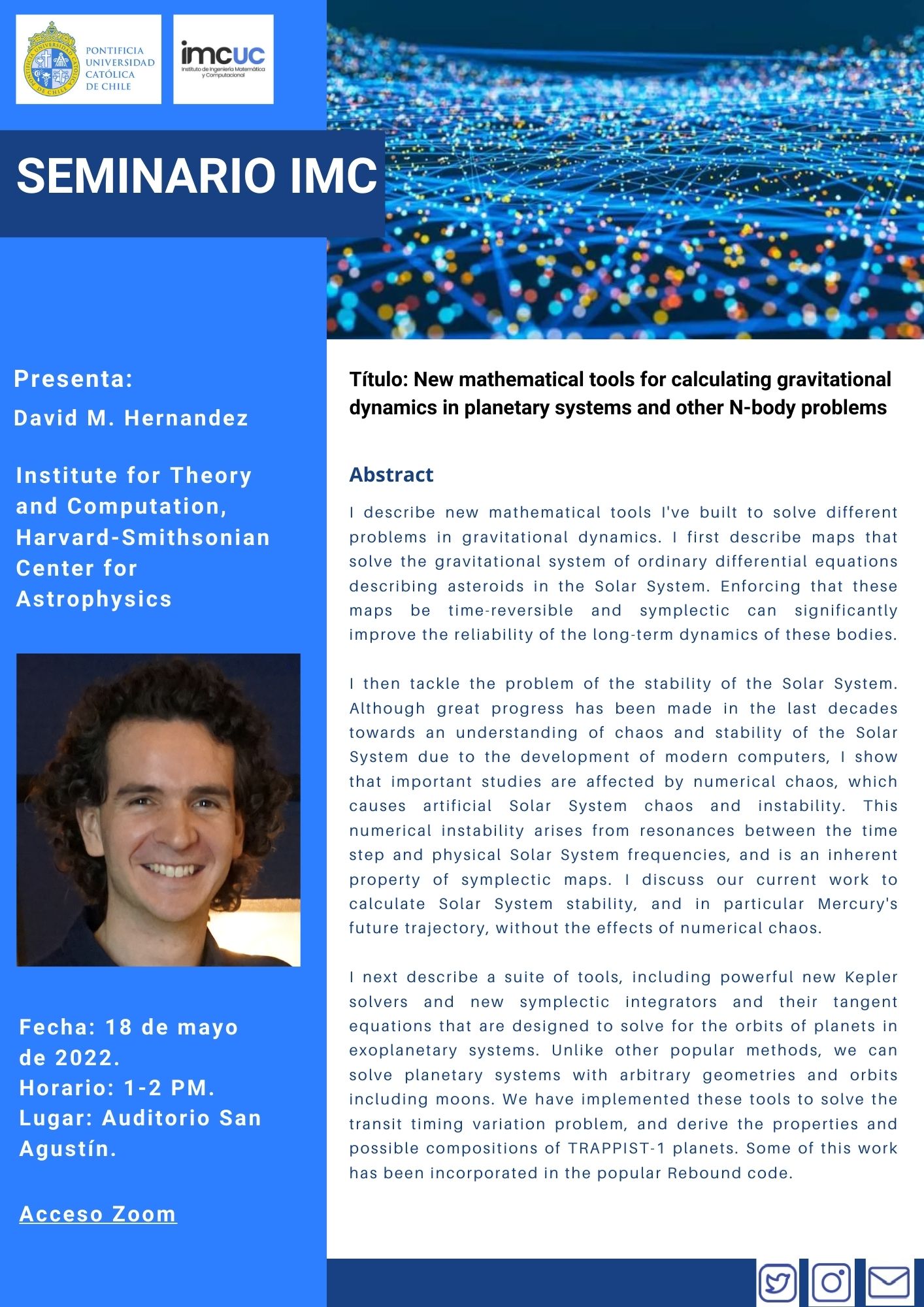El Instituto de Ingeniería Matemática y Computacional (IMC) los saluda atentamente y los invita al seminario que se dictará esta semana.
La charla se efectuará este miércoles 18 de mayo a las 13 horas, presencialmente en el auditorio del edificio San Agustín del Campus San Joaquín. Los que no puedan asistir en persona, también podrán tener acceso vía Zoom, cuyo link se puede obtener escribiendo al email Esta dirección de correo electrónico está siendo protegida contra los robots de spam. Necesita tener JavaScript habilitado para poder verlo..
La información sobre la charla la pueden encontrar en el poster adjunto y abajo.
Título: New mathematical tools for calculating gravitational dynamics in planetary systems and other N-body problems
Expositor: David M. Hernandez
Afiliación: Institute for Theory and Computation, Harvard-Smithsonian Center for Astrophysics
Fecha: 18 de mayo de 2022, 1:00 PM-2:00 PM
Lugar: Auditorio San Agustín; Zoom
Abstract:
I describe new mathematical tools I've built to solve different problems in gravitational dynamics. I first describe maps that solve the gravitational system of ordinary differential equations describing asteroids in the Solar System. Enforcing that these maps be time-reversible and symplectic can significantly improve the reliability of the long-term dynamics of these bodies.
I then tackle the problem of the stability of the Solar System. Although great progress has been made in the last decades towards an understanding of chaos and stability of the Solar System due to the development of modern computers, I show that important studies are affected by numerical chaos, which causes artificial Solar System chaos and instability. This numerical instability arises from resonances between the time step and physical Solar System frequencies, and is an inherent property of symplectic maps. I discuss our current work to calculate Solar System stability, and in particular Mercury's future trajectory, without the effects of numerical chaos.
I next describe a suite of tools, including powerful new Kepler solvers and new symplectic integrators and their tangent equations that are designed to solve for the orbits of planets in exoplanetary systems. Unlike other popular methods, we can solve planetary systems with arbitrary geometries and orbits including moons. We have implemented these tools to solve the transit timing variation problem, and derive the properties and possible compositions of TRAPPIST-1 planets. Some of this work has been incorporated in the popular Rebound code.
Bio:
David M. Hernández is a theoretical and computational astrophysicist. He is a Minor Planet Center Fellow and Institute for Theory and Computation associate at the Harvard--Smithsonian Center for Astrophysics (CfA). David obtained his Bachelor of Science degree at the University of Arizona, where he was an Arizona Flinn Scholar and U.S. Goldwater Scholar. David completed his PhD in June 2018 at MIT, where he was an NSF Graduate Research Fellow, and held a three-year MIT Lyons fellowship and a Shah Zion fellowship. His thesis, "Solving the N-body problem in astrophysics'', was supervised by Ed Bertschinger. Since his PhD, David has held postdoctoral positions, chronologically, at MIT, the CfA, RIKEN CCS, and again at the CfA. David's research focuses on applications of the mathematical N-body problem, which describes the motions of planets, stars, and galaxies.

.
